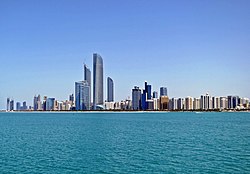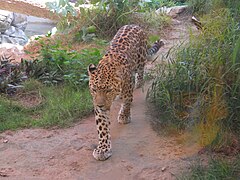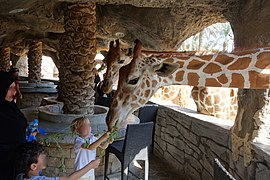Abu Dhabi Central Capital District, officially "Abu Dhabi Region" (Arabic: مِنْطَقَة أَبُو ظَبِي, romanized: Minṭaqat Abū Ẓabī),[4][5][6] also called "Abu Dhabi Metropolitan Area",[1][2][3] is the municipal region in the Emirate of Abu Dhabi that contains the city of Abu Dhabi, distinct from the Eastern and Western municipal regions of the Emirate. Abu Dhabi City is the capital of both the Emirate and the United Arab Emirates,[7] and has its own local government.[8]
Abu Dhabi Central Capital District Minṭaqat Abū Ẓabī (مِنْطَقَة أَبُو ظَبِي) | |
|---|---|
| Abu Dhabi Region[4][5][6] | |
 Skyline of Abu Dhabi City as seen from the Marina on the coast of the Gulf | |
![Location of the Central Region in the Emirate of Abu Dhabi[6]](http://upload.wikimedia.org/wikipedia/commons/thumb/e/ee/Abu_Dhabi_central.png/250px-Abu_Dhabi_central.png) Location of the Central Region in the Emirate of Abu Dhabi[6] | |
| Coordinates: 24°28′N 54°22′E / 24.467°N 54.367°E | |
| Country | |
| Emirate | |
| Seat | Abu Dhabi |
| Government | |
| • Type | Absolute monarchy |
| • Emir | Mohammed bin Zayed Al Nahyan |
| • Crown Prince | Khaled bin Mohamed Al Nahyan |
| • General Manager of City Municipality | Saif Badr Al Qubaisi |
| Time zone | UTC+4 (UAE standard time) |
| • Summer (DST) | UTC+4 |
Geography and description
Besides the city and island of Abu Dhabi, the region contains nearby settlements such as Al-Bahiyah, Mussafah, Khalifa City and Mohammed Bin Zayed City, and nearby islands such as Al-Aryam and Al-Saadiyat.[1][2][3] Khalifa City is in the vicinity of Zayed International Airport,[4] and Mafraq and Mussafah[9][10] are industrial areas, with the latter having a sea port.[11][12] As such, the region is economically important.[5][7] Settlements:[4][6]
- Abu Dhabi City (main settlement)
- Abu al Abyad
- Al-Aryam Island
- Al Bandar
- Al-Bahiyah[13]
- Al Falah
- Al Lulu Island
- Al Maryah Island
- Al Rahah
- Al Rahbah
- Al Reem Island
- Al Samhah
- Al-Shahamah[13]
- Al-Wathbah[13]
- Al Shamkha
- Bani Yas City
- Dalma Island
- Ghantoot
- Halat al Bahrani
- Jubail Island[14][15][16]
- Khalifa Industrial Zone
- Khalifa Port
- Masdar City[17]
- Mina' Zayed[13]
- Mussafah
- Saadiyat Island[13]
- Yas Island[13]
- Saadiyat Beach
Ecology
To the east of the island of Abu Dhabi is a national park with grey mangroves.[18] Arabic for "the Mangrove" is al-Qurm (ٱلْقُرْم),[19] and it is the name of a corniche that is popular amongst residents of the city, near Salam Street.[20]
The satellite town of al-Wathba has a Ramsar[21] wetland nearby.[22][23]
- Grey mangroves in Mangrove National Park, to the east of Abu Dhabi
Emirates Park Zoo
In the area of Al-Bahiyah, near the Abu Dhabi – Dubai highway, is located the Emirates Park Zoo And Resort (Arabic: مُنْتَجَع وَحَدِيْقَة ٱلْإِمَارَات لِلْحَيْوَانَات, romanized: Muntajaʿ Wa-Ḥadīqat Al-ʾImārāt Lil-Ḥaywānāt), which hosts over 1400 fauna, including rescued ones, and allows visitors to engage with them.[4][24] For example, in October 2018, there was a programme in which visitors could have lunch with leopards, particularly the Amur leopard.[25]
- An endangered Arabian leopard, which used to be recorded in the mountainous region of the country[26][27]
- Northern giraffes being fed by children
Transportation
Abu Dhabi island has four highways and four road bridges which all connect the island to the mainland namely Sheikh Zayed road (E10) with Sheikh Zayed Bridge, Abu Dhabi-Al Ain road (E22) with Maqta Bridge, Abu Dhabi-Sweihan highway (E20) with Mussafah Bridge and The Abu Dhabi-Al Falah highway (E12) with Sheikh Khalifa Bridge. The Sheikh Zayed Bin Sultan Street, also known as Salam Street, is one of the busiest streets in Abu Dhabi Island, and goes near the mangroves located to the east of the island. It connects Abu Dhabi with the mainland through the Sheikh Zayed Bridge. The Abu Dhabi-Al Falah highway (E12) connects Abu Dhabi island to Saadiyat Island, Yas Island and other islands and to the mainland.[20]
- The E 30 highway connecting Abu Dhabi City to Al Ain City in the Eastern Region, going through Mussafah Industrial City
- The E 11 highway leading to Dubai, passing through Ghantoot on the border of the Emirates of Abu Dhabi and Dubai
- Planes belonging to Etihad Airways at Zayed International Airport













